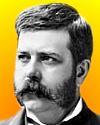
On 6 Oct 1846, George Westinghouse was born, the American engineer, inventor and industrialist who founded his own company to manufacturer his own invention (in the quiz below). Before he died, he had produced safer rail transportation, steam turbines, gas lighting and heating, and electricity. He was also chiefly responsible for the adoption of alternating current for electric power transmission in the United States.
In a paper presented in 1912 by William Stanley, there are some personal recollections of Alternating Current Development in America. He was involved in the Westinghouse Electric Company work which resulted in the building of the first alternating-current plant at Great Barrington in 1885. To his audience he said, it was difficult for engineers of 1912 to appreciate the conditions at the outset in 1885. Back then, there were but few books on electrical engineering, no formulae, except those hidden away in scientific papers, no nomenclature, and there was hardly any information about alternating-current phenomena available.
Stanley provides an interesting insight into the genesis of the alternating current power we now take so much for granted.

On 6 Oct 1846, George Westinghouse was born, an American inventor who introduced devices for safer rail transportation, steam turbines, gas lighting, and is especially remembered for being chiefly responsible for the adoption of alternating current for electric power transmission in the U.S. (prevailing over Edison's D.C. system). Today's book pick is: George Westinghouse: Gentle Genius, by Quentin R. Skrabec Jr., who provides a fine biography of this significant industrialist that is rich in drama and in breadth, a story of power, city building, and applying the Golden Rule in business. Westinghouse was a capitalist with a heart, for he also innovated in providing pension plans and planned communities for his workers. He was not only an inventor in his own right, but the orchestra leader of a symphony of ideas. Westinghouse developed the corporate model of invention and research. In 1955, over 55,000 employees voluntarily collected money for a memorial to Westinghouse.
It is available from Amazon, typically about New from $18.94. Used from $14.61. (As of earlier time of writing - subject to change.)
 | A rill in a barnyard and the Grand Canyon represent, in the main, stages of valley erosion that began some millions of years apart. |
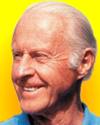 | Progress is man's ability to complicate simplicity. |
 | If someday they say of me that in my work I have contributed something to the welfare and happiness of my fellow man, I shall be satisfied. |
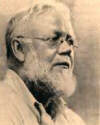 | An inventor is one who can see the applicability of means to supply demand five years before it is obvious to those skilled in the art. |
| Before you look at today's web page, see if you can answer some of these questions about the events that happened on this day. Some of the names are very familiar. Others will likely stump you. Tickle your curiosity with these questions, then check your answers on today's web page. | |
| Births | |
 | Thor Heyerdahl, born 6 Oct 1914, was a Norweigan ethnologist and adventurer who organized and led the famous transoceanic scientific expeditions intended to prove the possibility of ancient transoceanic contacts between distant civilizations and cultures. His first was a 101-day, 4,300-mile drifting voyage (1947) from Peru to Polynesia on a 40-sq.ft. raft, a replica of a pre-Inca vessel. What was this raft named? |
 | George Westinghouse, born 6 Oct 1846, was an American inventor and industrialist who was chiefly responsible for the adoption of alternating current for electric power transmission in the U.S.). Yet, he was also an innovator in other fields. His invention with which he first started his manufacturing enterprise was significant, though not electrical. What invention was manufactured by this scientist's first company? |
| Deaths | |
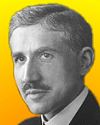 | Otto Fritz Meyerhof (1884-1951) was a German biochemist and corecipient, with Archibald V. Hill, of the 1922 Nobel Prize for Physiology or Medicine for research. What did his research demonstrate? |
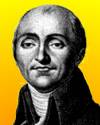 | Bernard-Germain-Étienne Lacépède (1756-1825) was a French naturalist who was interested in herpetology and ichthyology. He added several volumes in animal classification to the series Histoire Naturelle started by Buffon. What forms of life are studied in herpetology and ichthyology? |
| Events | |
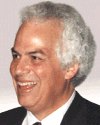 | On 6 Oct 1997, American biology professor Stanley B. Prusiner was awarded the Nobel Prize for Physiology and Medicine to recognize his discovery of what was described as “an entirely new genre of disease-causing agents.” What had he discovered? |
 | On 6 Oct 1956, Dr. Albert Sabin reported that the polio vaccine he had developed was ready for mass testing in the U.S. and four other countries. How was this polio vaccine administered? |
Fast answers for the previous newsletter for October 5: amino acids from the cytoplasm of a cell to a ribosome • The old Roman name for Copenhagen was Hafnia • massive supercomputers • Steve Jobs • Mach 8 • Edwin Hubble.
 If you enjoy this newsletter, the website, or wish to offer encouragement or ideas, please send feedback by using your mail reader Reply button.
If you enjoy this newsletter, the website, or wish to offer encouragement or ideas, please send feedback by using your mail reader Reply button. Your click on a Facebook, StumbleUpon, or other social button on the site webpages is also a welcome sign of appreciation. Thank you for using them.
© This newsletter is copyright 2020 by todayinsci.com. Please respect the Webmaster's wishes and do not put copies online of the Newsletter — or any Today in Science History webpage. (If you already have done so, please remove them. Thank you.) Offline use in education is encouraged such as a printout on a bulletin board, or projected for classroom viewing. Online, descriptive links to our pages are welcomed, as these will provide a reader with the most recent revisions, additions and/or corrections of a webpage. For any other copyright questions, please contact the Webmaster by using your mail reader Reply button.
--
If you do not want to receive any more newsletters, Unsubscribe
To update your preferences and to unsubscribe visit this link
Executive Real Estate Business Class
-
"It was like a man with wings. It wasn't like anything you'd see on TV or in a monster movie." ...
About the publisher
Search This Blog
Blog Archive
-
▼
2020
(1542)
-
▼
October
(171)
- The Compass: Iceland
- A Very Special Halloween Edition Of Our Scariest S...
- On This Day for October 31 - Luther's Ninety-five ...
- Newsletter for Saturday 31 October.
- CORONAVIRUS UPDATE: Why some people are supersprea...
- October 31: Martin Luther Challenges the Pope, Mic...
- PHOTOGRAPHY: Capturing America's pent-up energy to...
- The Terrifying Story Of The Mothman, The Little-Kn...
- The Roundup Top Ten from History News Network
- On This Day for October 30 - Henry Tudor crowned k...
- Newsletter for Friday 30 October.
- October 30: Tsar Nicholas II 'October Manifesto', ...
- ANIMALS: Will oil drilling spread across spectacul...
- On This Day for October 29 - Collapse of U.S. stoc...
- Newsletter for Thursday 29 October.
- October 29: End of China's One-Child Policy and Lo...
- YOUR WEEKLY ESCAPE: The science of the heebie-jeebies
- SCIENCE: Will every hurricane season be like this?
- The Latest News from History News Network
- On This Day for October 28 - Statue of Liberty ded...
- Newsletter for Wednesday 28 October.
- October 28: Fingerprints, Prohibition and the Blac...
- TRAVEL: When do Americans say they’ll fly again?
- Were vampire hunters real? Subscribe to find out.
- On This Day for October 27 - Anwar Sadat and Menac...
- Newsletter for Tuesday 27 October.
- October 27: China's Population Reaches 1 Billion a...
- HISTORY: Rush of early voters spurs talk of a record
- New This Week on History News Network
- On This Day for October 26 - Park Chung Hee assass...
- Newsletter for Monday 26 October.
- October 26: Beginning of the Red Cross and the Gun...
- FAMILY: When the best advice to your kids isn't yours
- On This Day for October 25 - English triumph at Ag...
- Newsletter for Sunday 25 October.
- October 25: The Great United Nations China Switch ...
- The Compass: Japan
- On This Day for October 24 - United Nations establ...
- Newsletter for Saturday 24 October.
- October 24: Two Great Historical Stock Market Crashes
- CORONAVIRUS UPDATE: How to fight the COVID-19 'inf...
- PHOTOGRAPHY: The best photojournalism of the decade
- What did Cleopatra look like? | Charles and Diana’...
- 11 Spooky Urban Legends Based On Terrifying True S...
- The Roundup Top Ten for October 23, 2020
- On This Day for October 23 - U.S. and French troop...
- Newsletter for Friday 23 October.
- October 23: US National Debt, an Old Fossil and th...
- ANIMALS: They were researching cheetahs. Iran call...
- Love the show Weird But True? Get more WBT with ev...
- Early Holiday Savings at the HISTORY Store
- Introducing the Britannica All New Kids' Encyclope...
- On This Day for October 22 - Cuban missile crisis,...
- Newsletter for Thursday 22 October.
- YOUR WEEKLY ESCAPE: These prehistoric footprints t...
- October 22: Greenwich Mean Time, the Cuban Missile...
- SCIENCE: Will the next generation fight a pandemic...
- On This Day for October 21 - Magellan's discovery ...
- The Latest News from History News Network
- October 21: Battle of Trafalgar, China Occupies Ti...
- TRAVEL: We found 50 stories in 50 states for ‘Amer...
- On This Day for October 20 - Opening of Sydney Ope...
- Newsletter for Tuesday 20 October.
- October 20: On This Day in History
- HISTORY: Why do we have the Electoral College?
- Join photographer Pete Muller for an online conver...
- New This Week on History News Network
- On This Day for October 19 - Surrender of Lord Cor...
- Newsletter for Monday 19 October.
- October 19: On This Day in History
- FAMILY: Letting kids take charge
- The lost heirs of Henry VIII
- On This Day for October 18 - Alaska Purchase appro...
- Newsletter for Sunday 18 October.
- October 18: French Protestants, The Alaska Purchas...
- The Compass: Portugal
- On This Day for October 17 - Mother Teresa awarded...
- Newsletter for Saturday 17 October.
- October 17: Burma Railway, OPEC Oil Embargo and Ra...
- CORONAVIRUS UPDATE: Who will be first in line for ...
- PHOTOGRAPHY: How COVID-19 changed our work
- The 25 Best Horror Movies Of All Time — And The Ch...
- This Week's Roundup Top Ten from History News Network
- On This Day for October 16 - Marie-Antoinette guil...
- Newsletter for Friday 16 October.
- October 16: Battle of Leipzig, Mao's Long March an...
- ANIMALS: The wildlife photo of the year
- Challenge grant: Help unlock important funds for w...
- On This Day for October 15 - Final conference on A...
- Newsletter for Thursday 15 October.
- October 15: Napoleon's Exile, the 1st Oral Contrac...
- YOUR WEEKLY ESCAPE: A murder mystery 430,000 years...
- SCIENCE: Will the next generation fight a pandemic...
- The Latest News on History News Network
- On This Day for October 14 - Battle of Hastings, D...
- Newsletter for Wednesday 14 October.
- Historic Trends in our time may be overcome with g...
- October 14: William the Conqueror, Robert the Bruc...
- The Embarrassing Final Moments Of 10 Revered Histo...
- TRAVEL: Does your wine taste like fire?
-
▼
October
(171)
-
Blogroll
-
About
HistoryFact










0 comments:
Post a Comment